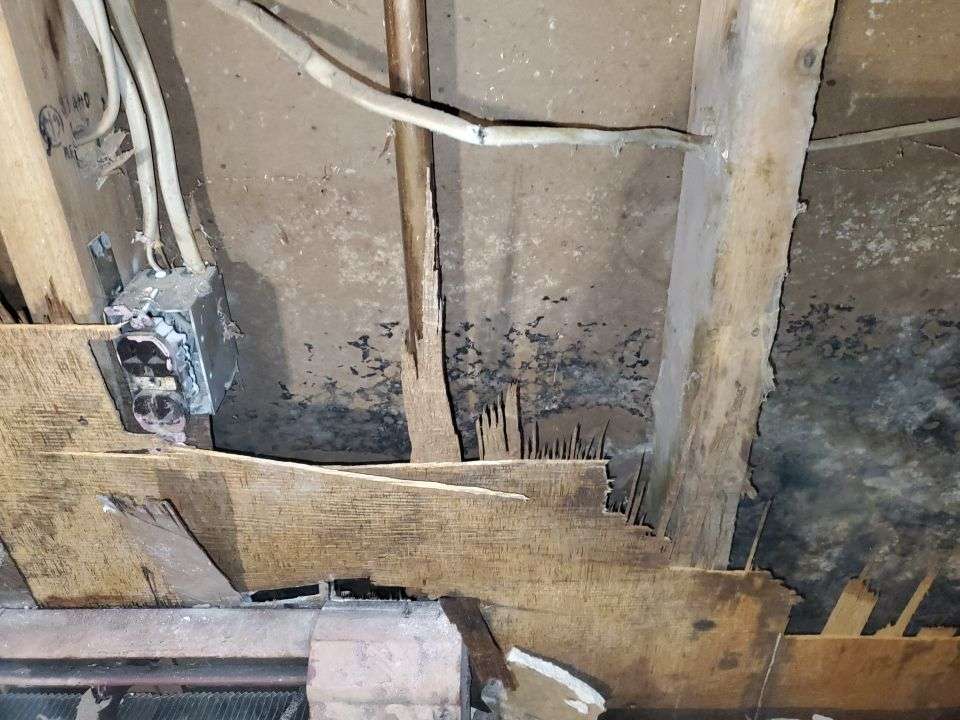You can do many things to prevent mold growth after a flood or leak in your home. Homeowners in wet regions like southeast Pennsylvania often experience water damage from floods and plumbing leaks. This excess moisture can be challenging to clean up, and the damage left behind can be devastating. Most of the time, people clean the excess water visible on top of surfaces, believing that wet materials will dry over time.
But we always say that water does not just disappear on its own!
One of the unfortunate consequences of water in homes is potential mold growth. In this article, we’ll explore 6 effective ways to prevent mold from spreading after a water or moisture issue in your home and how to create ideal climatic conditions to prevent mold growth.
Clean Up Quickly
The most important step you can take following a leak or flood is to clean up the mess as quickly as possible. That means extracting any standing water, wiping down surfaces with damp cloths, and using professional fans and dehumidifiers to dry out any areas exposed to moisture as quickly as possible.
The longer it takes for an area to dry out, the higher the chances of mold growth will become. So ensure you have enough fans and dehumidifiers for the surface you try to dry.
Remember that mold develops on porous surfaces within 48 to 72 hours. That’s very fast. So, do not take a chance; act immediately.
Disinfect and Deodorize
When cleaning affected surfaces after a flood or leak, it’s important to use EPA-registered disinfectant products. The Safer Choice label guarantees that EPA scientists have rigorously examined every ingredient in the product, ensuring it meets a high safety standard. Do not use any detergent.
Why is disinfection necessary?
It is an effective way to kill off existing mold spores before they can grow into colonies and spread, which is key when trying to prevent mold growth in your home after a flood or leak.
Remove Any Damaged Materials
Building materials, such as carpets, furniture, or drywall, can become badly damaged by moisture or flooding and beyond the point of salvation. In that case, removing them from your home as soon as possible is crucial since they are likely harboring mold spores that could spread throughout your house if left unchecked.
Remember that the longer you leave materials soaking in water or wet, the greater the damage. If you want to prevent mold growth, you must act fast. If you do not act immediately and discover water damage after a few hours, removing non-salvageable items will be necessary.
Install Air Purifiers
Air purifiers are great for removing tiny particles such as dust mites and pollen from your air, but they can also be used to eliminate airborne mold spores that may have entered your home due to excess moisture or flooding.
Having an air purifier running 24/7 can help keep your air free from these dangerous particles so that you don’t have to worry about them settling on any surfaces where they could cause more issues later on down the line. Air purifiers are a great technology that can help prevent mold growth.
Invest in High-Quality Ventilation Systems
Poor ventilation systems can contribute significantly towards increased humidity levels within your home, leading directly to increased levels of potential mold growth throughout your house.
So ensure you invest in high-quality ventilation systems that circulate fresh air throughout all rooms evenly without allowing too much humidity to build up in certain areas over time.
Monitor Humidity Levels Regularly
The final step you should take when attempting to prevent mold growth within your home is monitoring humidity levels regularly. It will give you an idea of when there might be a problem before it gets too serious and requires professional intervention.
Keeping track of humidity levels within each room via digital thermometers is easy enough for anyone with basic technical knowledge. So, you do this regularly if you want true peace of mind over time!
Here Is Some Food For Thoughts
Water damage is never fun, but dealing with its mold aftermath can be manageable too! By following these six steps:
- Cleaning up quickly
- Using EPA-certified disinfectants
- Removing damaged materials
- Installing an air purifier
- Investing in high-quality ventilation systems
- Monitoring humidity levels regularly
Following these steps can help ensure that household mold growth won’t become an issue after a flood or leak occurs in your home again. With these tips under your belt and some consistency in practice over time, preventing household mold has never been easier! Mold is extremely serious and does require a professional to remediate any damage properly. You can contact a restoration company like FastPro Restoration to help throughout the process and avoid costly mistakes. We offer both mold testing and mold remediation services.



